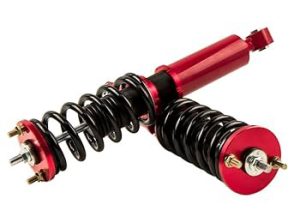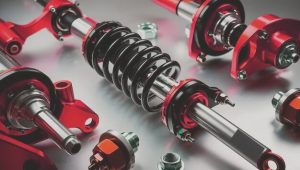Shock absorbers (also called dampers) are essential parts of any vehicle’s suspension. They help control body motion, maintain tire contact with the road, and provide comfort and safety. But despite their importance, many misconceptions about how they work, when to replace them, and what they do persist. In this article, we debunk the most common myths about shock absorbers, drawing on expert sources and technical facts.
If you decide your shocks are worn or you want to upgrade, you can always buy Shock Absorbers online from reliable suppliers.

Myth 1: Shock Absorbers “Hold the Car Up”
The myth: Shock absorbers support the weight of the vehicle and keep it lifted.
The truth: It’s the springs (coil, leaf, torsion bars) that carry the static load of the car. Shocks only regulate motion of that load.
“It is a common misconception that shocks support the weight of the car, but they do not. That’s what the springs are for.”
Shock absorbers act as hydraulic (or gas-oil) dampers, resisting motion of the springs. Removing shocks won’t cause the car to drop; it will bounce uncontrollably instead. Many shock experts clarify this — shocks control oscillation, not provide support.
Myth 2: Stiffer Shocks Always Give Better Handling
The myth: The harder the shock, the better the handling and stability.
The truth: Handling performance is about balance. Overly stiff shocks can increase harshness, reduce contact on uneven roads, and worsen ride quality.
Bilstein’s technical fact-check states that overly rigid damping or improper bump stops can actually overstress suspension and reduce comfort or control.
Street driving demands a blend — firm enough to limit body motion, yet compliant to maintain traction over irregular surfaces. Simply cranking damping up is not a universal improvement.
Myth 3: All Gas Shocks Are Gas-Only (No Oil Inside)
The myth: A “gas shock” contains only gas (nitrogen) and no hydraulic fluid.
The truth: All modern shock absorbers are essentially oil-filled devices; the gas is used to pressurize and reduce foaming (aeration).
As explained in technical resources, gas pressure is used to suppress bubbles in the oil and maintain consistent damping under dynamic loads.
Thus, even in a “gas shock,” oil is still doing the heavy work of damping.
Myth 4: You Must “Pump” Twin-Tube Shocks Before Installing
The myth: Twin-tube dampers require pre-pumping to “prime” them before mounting.
The truth: That step is unnecessary. Twin-tube shocks are designed to fill the working chamber naturally once installed. Bilstein verifies that pre-pumping provides no benefit and is not required.
Shocks often ship horizontally or at various angles, but repositioning during installation does not demand special handling beyond following manufacturer orientation guidelines.
Myth 5: Shock Absorbers Show Visible Wear Like Tires
The myth: Worn shocks display obvious visual signs like cracks or tread-like wear.
The truth: Shock absorbers generally degrade internally without dramatic external changes. They rarely “look” bad until failure is advanced.
Hemmings notes that unlike tire treads, shock wear is subtle and usually internal — seals may begin leaking gradually, damping forces diminish, but outward appearance may remain pretty normal for a long time.
Thus, relying solely on visual cues is risky; performance and internal inspection are critical.
Myth 6: Shock Absorbers Are the Same Everywhere
The myth: Any shock absorber of correct length and size will deliver similar performance.
The truth: Valving, internal design, damping curves, and oil/gas pressures all differ, leading to dramatic performance differences.
ShockWarehouse notes that shocks are one part of a larger suspension system, and changing just the shocks will not produce dramatic changes in ride by itself.
Choosing high-quality units with proper specifications is far more important than using generic ones.
Myth 7: Shocks Should Be Replaced at Fixed Mileage (e.g., 30,000 mi)
The myth: Shock absorbers must be replaced at a fixed interval like 30,000 miles.
The truth: There is no universal “expiry date.” Longevity depends on road conditions, driving style, load, and shock design.
ShockWarehouse points out that the “30,000 miles rule” is often a sales pitch; shocks should be replaced when their damping performance drops, not solely by mileage.
Experts recommend performance testing or inspection rather than rigid intervals.
Summary: Myth vs. Reality at a Glance
| Common Myth | Reality / Expert Insight |
|---|---|
| Shocks hold up the vehicle | Springs support static load |
| Stiffer shocks always better | Over-stiffness reduces comfort, may harm traction |
| Gas shocks = no oil | All modern shocks use hydraulic fluid + gas |
| Twin-tubes must be pumped | No priming is necessary before installation |
| Shock wear is visually obvious | Most wear is internal, not easily seen |
| All shocks are functionally equal | Valving and design vary significantly |
| Fixed replacement mileage needed | Replace when performance degrades |
Final Thoughts & Recommendations

Shock absorbers are often misunderstood, but understanding these myths can help you make better choices:
-
Evaluate shock performance by ride behavior, not just appearance.
-
Prefer quality units with appropriate damping characteristics over cheap replacements.
-
Don’t overdo stiffness in search of performance — balance is key.
-
When you need new units, pick trusted products suited to your vehicle and driving style.
Ready to upgrade or replace? You can buy Shock Absorbers online and choose from a wide array of high-quality options that match your vehicle’s needs.
If you like, I can follow this with a shorter “Myths for Beginners” version you can use in a blog sidebar or product page teaser.